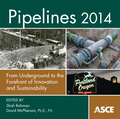Soil Parameters for Assessing Axial and Transverse Behavior of Restrained Pipelines—Part 2: Transverse Behavior
Publication: Pipelines 2014: From Underground to the Forefront of Innovation and Sustainability
Abstract
Understanding soil-structure interaction behavior of the pipe-soil interface is essential in the characterization and assessment of thrust restraint resistance mechanisms in buried pipelines. Two primary forms of resistance mechanisms, axial and transverse, contribute to the resistance of unbalanced thrust forces that arise at a bend, valve, tee, or other similar sources of thrust in a buried pressure pipeline. The individual contribution from each mechanism depends on the material properties and constitutive relations of the pipe segments, pipe joints, soil, and the soil-pipe interface; internal and external loadings on the pipeline; and installation conditions. In the water/wastewater industry, pipeline designers frequently rely on guidance from AWWA standards and design manuals. These guidance documents are developed by distinct material-specific standard committees, and the contents are based on differing simplifying assumptions, theories, and design philosophies and are often uncoordinated. In most cases, the rationale behind the recommended soil parameters is either undocumented or based on unidentified assumptions. This practice leads to inconsistent guidance on selection of soil parameters for use in the soil-structure interaction analysis of different pipe materials and makes improvement of design practices extremely difficult. The soil parameters employed to assess transverse soil-structure interaction behavior are related to the analysis method adopted, such as passive resistance theory, bearing-capacity theory, beams on elastic foundation theory, and P-y curves for the case of transverse resistance. The lateral resistance to the transverse movement of the pipe depends on a variety of factors, including the type of soil, the depth of embedment, the magnitude of the pipe movement against the soil, and the direction of the pipe movement. Different lateral stiffness or subgrade soil moduli are to be expected for a horizontal bend, a vertical upward bend, and a vertical downward bend located in similar soil conditions. P-y curves existing in the literature for lateral pile analysis problems require modifications for application to pipelines with transverse loading. This paper reviews different theories for transverse soil-interaction behavior and identifies P-y curve theories appropriate for such analysis of restrained pipelines located in different types of soils. It presents general approach and derivations of P-y curves for pipelines located in sands and clays. The paper also provides recommendations for soil parameters needed to model lateral resistance of pipelines to transverse movements. These parameters include friction angle, cohesion, unit weight, subgrade modulus, and strain corresponding to one half of the maximum principal stress difference.
Get full access to this article
View all available purchase options and get full access to this chapter.
Information & Authors
Information
Published In
Copyright
© 2014 American Society of Civil Engineers.
History
Published online: Aug 4, 2014
Authors
Metrics & Citations
Metrics
Citations
Download citation
If you have the appropriate software installed, you can download article citation data to the citation manager of your choice. Simply select your manager software from the list below and click Download.
